The Three Biggest Mistakes of Building a Bot
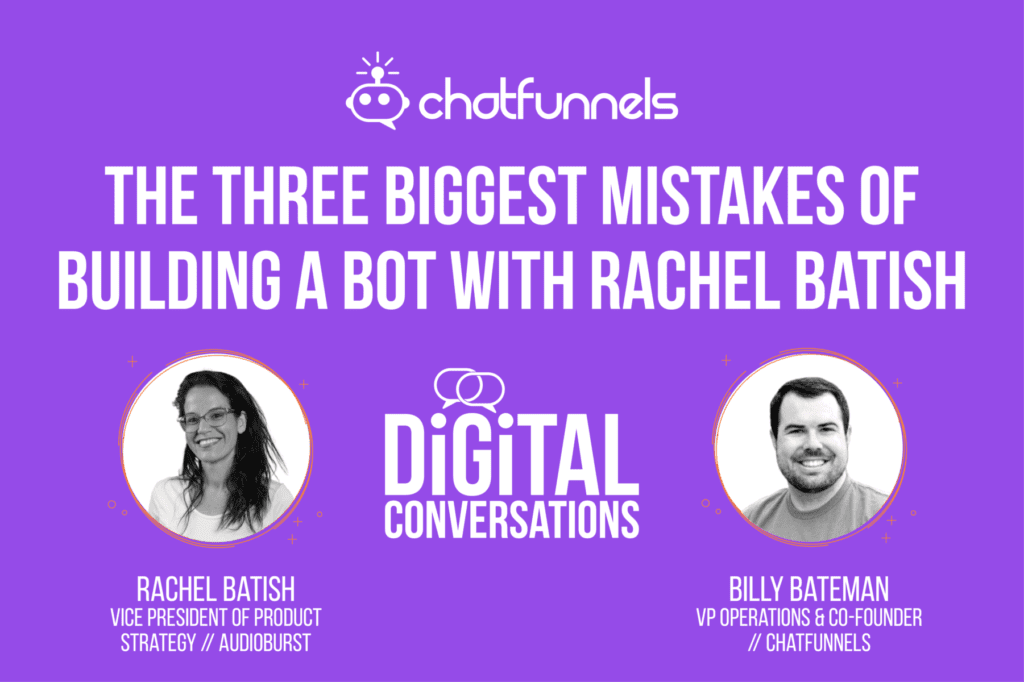
Reading Time: 13 minutes
Overview: In this episode of Digital Conversations with Billy Bateman, we are joined by the brilliant Rachel Batish. She gives best practices to building a bot, shares some future use cases for voice bots and talks about how to create a good experience for your customer.
Guest: Rachel Batish-Rachel is an experienced and hands-on entrepreneurial front-runner. She has successfully developed and implemented strategies for dynamic startups and projects for the past 13 years in both the private and the non-profit sectors, from inception to execution, and from initial revenues to large-scale turnover.
She is passionate about working with people and cultivating relations with her customers, partners, colleagues, investors and employees.
Listening Platforms:
data:image/gif;base64,R0lGODlhAQABAAAAACH5BAEKAAEALAAAAAABAAEAAAICTAEAOw==
Transcript
Billy: Alright everyone, welcome to digital conversations. I’m your host Billy Bateman and this week I am joined by Rachel Batish, Vice President of product strategy and US site manager for Audio Burst. Rachel, thank you for joining us today.
Rachel: Hi Billy, thank you for having me. Hi everyone!
Billy: We’re excited to have you. I think you’ve got a lot of great insights to share with everybody. Before we jump into it I just wanted you to tell everybody who you are, what your background is and what you’re doing right now.
Rachels Background
Rachel: Cool, so I’m Rachel and I live in San Jose California. Been here for a little bit over 2 1/2 years. I moved to the US almost five years ago from Israel. I moved with my first startup Zoos Now that I found. Which pivoted into Conversation One which was my first encounter with chatbots and actually voice bot. Conversation One was a build once, deploy anywhere platform for conversation applications back at the time when Alexa just came out to the market. And the Google home was just about to come out. We focused our capabilities on financial institutions. We worked with credit unions and banks insurance companies.
The cool thing about it was that we were one of the first to actually leverage AI to understand how we can improve the bot by analyzing previous conversations, extracting intent and then applying that on future conversation. So that was the great promise of Conversation One.

Unfortunately just like so many other startups things didn’t go as well or as much as we wanted them to. Anyway in 2019 I joined Audio Burst. I’m Vp of product strategy. Audio Burst is a very unique company in the voice space because we’re actually focusing on the audio side. We’re providing a personalized listening experience for end users when it comes to spoken word audio. So everything that is not music.
We have our own proprietary system that analyzes spoken word audio on the fly. It analyzes approximately 7 million minutes a month of spoken word audio on both radio and podcasts. And then we deliver it in short form. We have a system that transcribes and segments and then indexes all of this content and then sends it back to the user in 30 seconds to four or five minutes.
We’re doing a lot to add the experience of voice activation. I would say we’re still at the beginning of actually kind of adding the bot experience into the system. But understanding the focus of voice activation and it’s something that we work on constantly.
Anyways just before we left Conversational One me and my cofounder, I also released a book about conversational design called voice and chatbots conversational design. It was a great project for me. I loved it and hated it and at the same time. It was really great to explore and kind of bring all of my thoughts on the paper but it took a lot of weekends and nights and time away from my family. But I was very proud when it came out. I love it when people write to me, we really found it useful. I wrote it also from a non-tax perspective.
My background is not technical. I actually studied political science and international relations so I kind of evolved into the high tech scene through my experience in defining products and sometimes a little bit also from the marketing and sales experience. When we pivoted into Conversation One that was a place where I knew that I had a lot to contribute in terms of, how do you build a bot? What should that experience be like?
Billy: Yeah building a bot is not as easy even with all the great tools you have now, where you don’t have to be technical to build one, you just have to be savvy enough to learn how to use a piece of software but still not easy. Now in your book, I love the title of chapter 2 actually, “how not to build your next chat and voice bot”. Do you mind sharing, here are my big no nos for building a bot?
3 Mistakes People make when Building a Bot
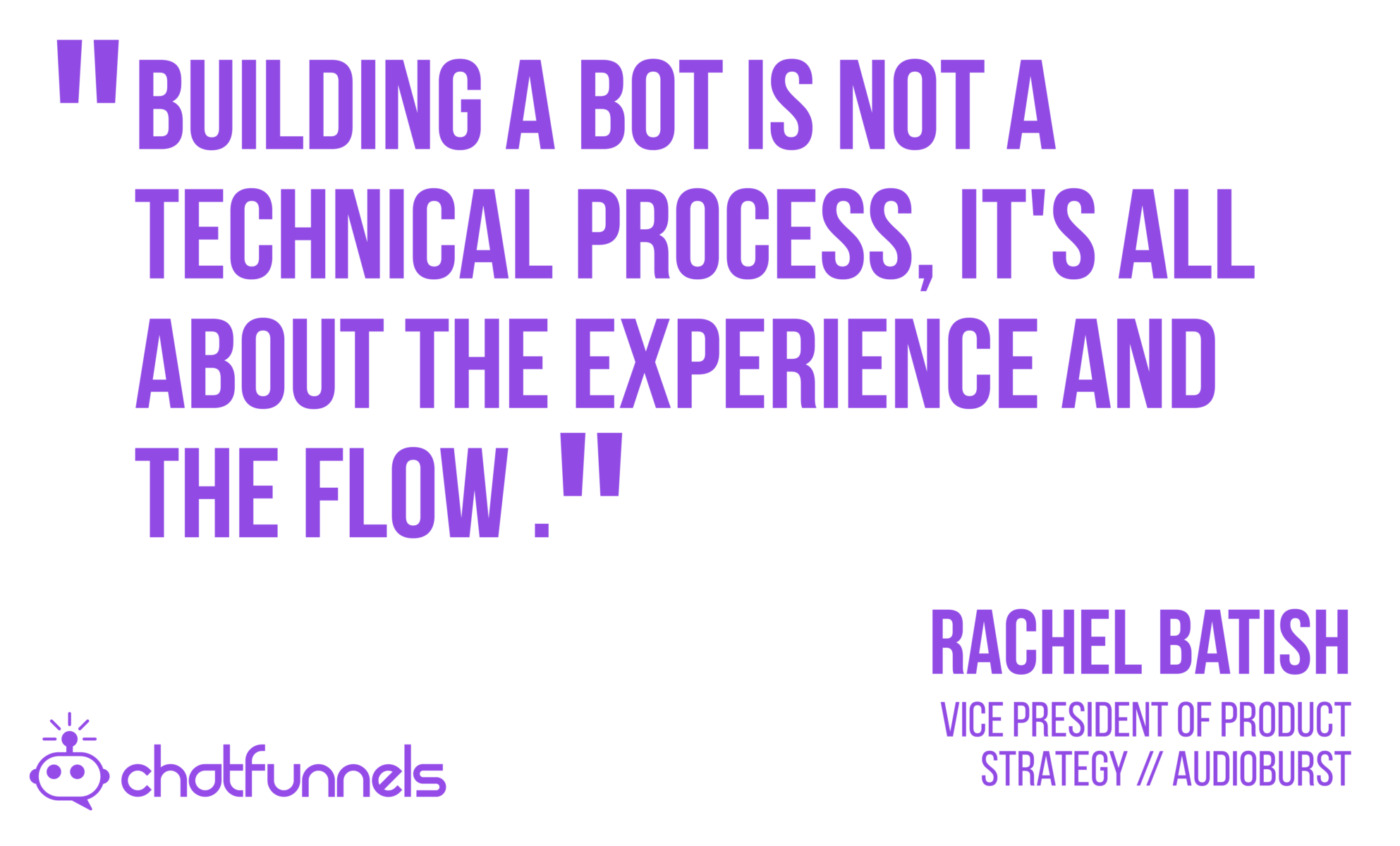
Rachel: Yeah so I think you kind of nailed it also at the beginning of the sentence. So building a bot is not a technical process. I mean there are the technicalities of what you need to do but it’s all about the experience and the flow and actually how you create the bot to do what it’s supposed to do. So building the conversation. Which we’ve seen requires a whole different type of people and new roles popped up in the market. You have people that are conversational designers right.
So they just like we had the GUI we moved into the vui and people that could actually define that. So I think actually there are a lot of no no’s in the book. But I did write down three that I know that I always tell people who consult and ask what’s the best way to approach building a bot.
Don’t Botanize the Bot

So the first one is don’t botanize the bot and I’ll explain what that means. So not botanizing the bot means that we need to understand what’s the purpose of actually building a bot. We’re replacing a human interaction with a computer one. So instead of looking at what we built originally on our website or on a web form and then taking that and building a bot out of it. I always tell people to go back to what the original purpose was. So the original purpose being when we build it on a website or a form was that people will not call someone. But in the process of not calling someone we reduced a lot of the capabilities into a webview or a web form.
And instead of taking that webform and trying to botanize it, go back to the human who did that role or had that commission at the beginning and try to make that into a bot. So the bot is replacing the human, it’s not replacing the web view or the web form that we built.
I think that this is my number one tip of what not to do and definitely what to do. I think this is something that when people hear about it and when we do that we’re actually looking at what we had on our website and we’re converting it into a conversation. Whereas we had the conversation as a beginning. So we just need to see how we can not botanize that but make that into a bot. So an example would be if it’s a travel agent. Don’t try to fill forms or something like that in the bot experience but try to think what a travel agent would ask you and how can you make a bot out of it. I think that’s the big no no and number one. I think the other two are pretty obvious today.
Don’t build it then forget it
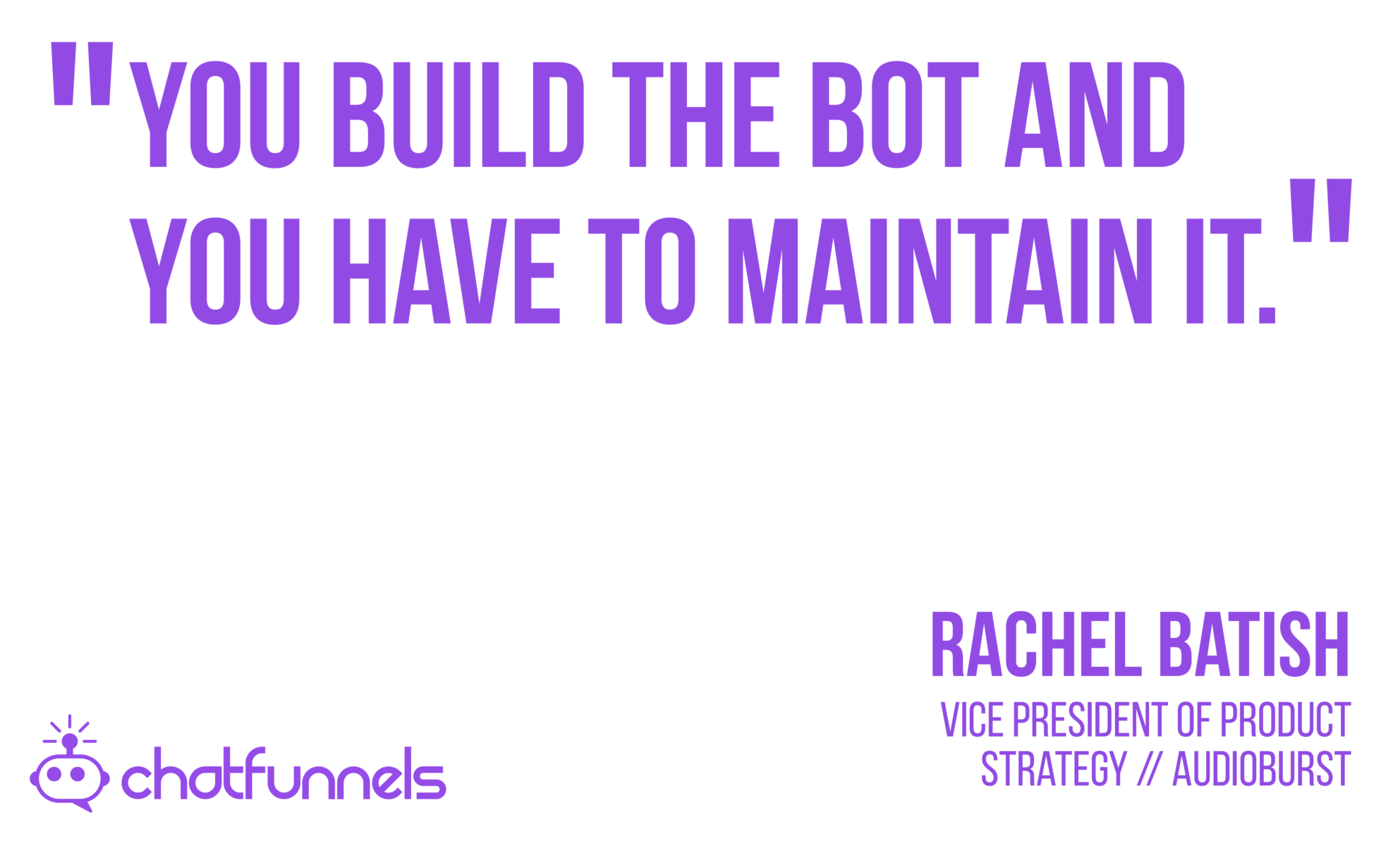
So the second one is don’t build then forget it’s not a one time gig. Building a bot is like everything else in tech, and even more I think maybe if you put up a web page it could last forever, but with a bot you build it and you have to maintain it. And there are a lot of insights that we should take also from the experience of that bot. So I’ve mentioned with Conversation One we would analyze the previous conversation to improve the next one.
The greatest challenge with building a bot is the fact that it’s unlimited. We can ask anything. Like even if I’m on geico’s insurance website I can ask I don’t know what the best trial travel agents are. And it doesn’t mean that we have to provide that answer. But we need to think of what’s the best way to respond to those questions and how do we learn from them. We don’t build and forget. Make sure that your bot is becoming, I wouldn’t say smarter because I don’t think that they are smart but they should get more and more effective.
Billy: I agree with you 100% on both points but especially on this do not set it and forget it. You should constantly be looking and just look at the flow whatever the goal for the bot is and figure okay where am I losing people along the way? And how do we change it to correct that for conversion? Whatever the goal is whether it’s, let’s get an email from somebody that’s getting them to sign up for this or book a meeting. Or even if it’s just helping them find what they need on a website. Look at where we’re losing people and then run a new test.
Rachel: So I think it’s where I’m losing people and where I can provide additional support.
Define your Use Cases
So the third one is to define your use cases. I always say not too little but not too much. So a bot grows gradually, up at the beginning you have a specific use case you build things around it, you test it, you put it out to the public and then you see how people are reacting to it. And in most cases people would not react well to it so you’ll have to go back and do the changes and see how people are actually talking to the bot. Sometimes we have that thing that we think okay people will probably say “123” and we find out that though they say it in a different way.
So definitely focus on the original use case and build it to succeed. So that people don’t get frustrated at the beginning and then as you continue to analyze and kind of build the use cases and fill the scope and show people that you’re actually listening to them and you understand what they’re looking for. Another good example by the way is also if you building a bot on a website. If I’m on a specific page you can already know what I’m actually looking for within that brow.
So you can narrow down also the understanding level of the bot to that specific page. It might be that I’m looking for something else but probably in the US that’s going to be like 80/20%. So there’s a lot of ways and I think at the end it goes back to serving the customer. So eventually the customer is frustrated and it kind of did nothing with our great bot that we built.
Billy: Yeah, those are all great points. Thank you for sharing those. So you’re doing some work with voice now at Audio Burst and I just wanted you to tell us how you are incorporating what you learned with Conversation One and writing this book into the product at audio burst?
Focus on the customers needs
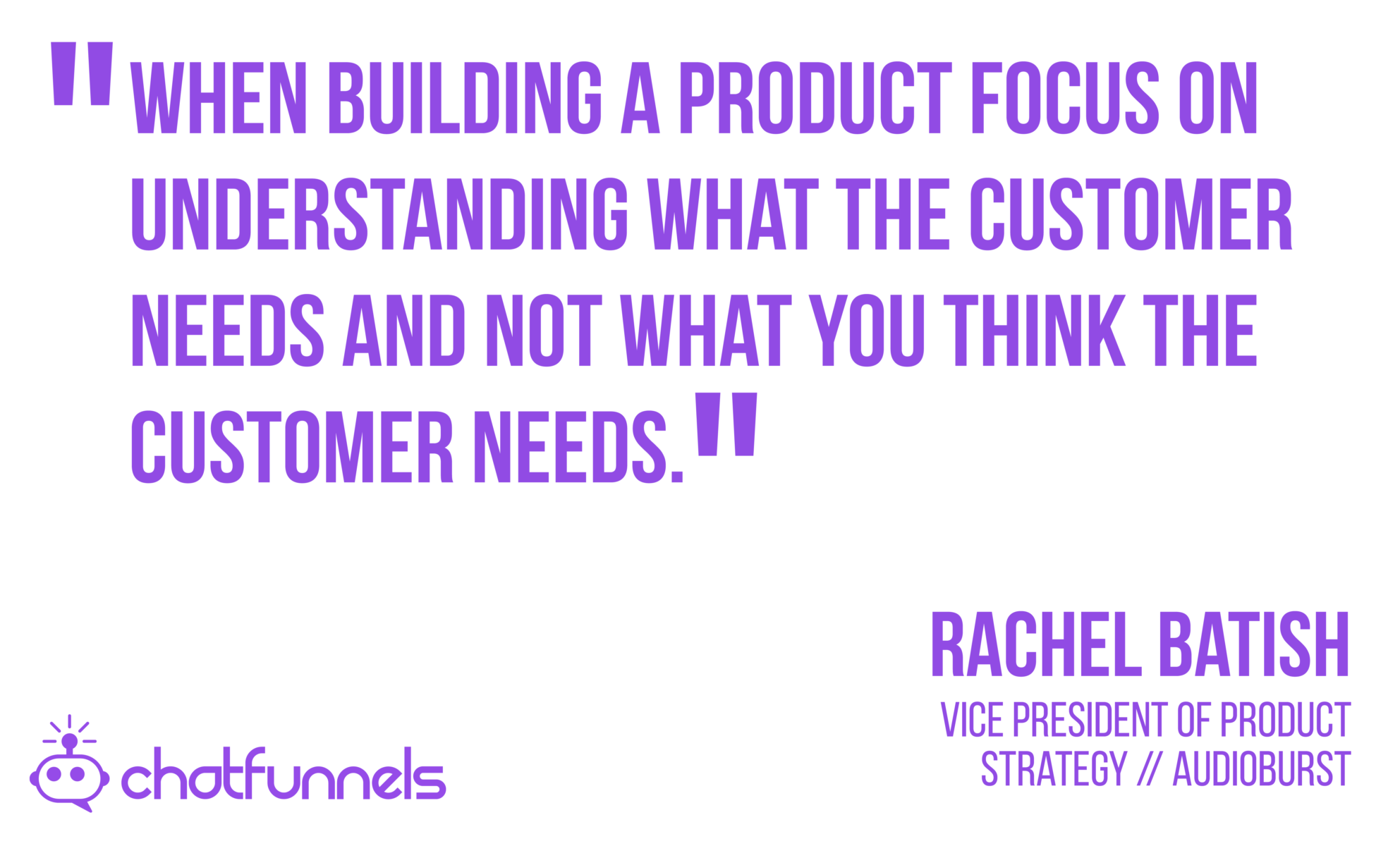
Rachel: Yeah, I think that in general my experience with Conversation One and also now. When building a bot was focusing on understanding what the customer needs and not what I think the customer needs. I think that’s a great lesson for every product manager to take with them. Instead of going and writing the first line of code or your first conversational VUI just think for a second, is that actually solving a real pain point for that customer. What I would say that this is the one thing that I always carry with me and I bring before even thinking about solving it.
So when I joined the Audioburst I was immediately thinking oh we have to do a bot. We have to include a bot in the experience. Actually Audioburst had that virtual system that would read people before they would listen to the content, it would tell them you know where it was broadcasted before and it was telling you what’s the title of that specific title of that specific audio clip which we called burst. But then I listened to it, I said it works perfectly right.
She tells you the name of the burst, she tells you where it was taken from, she tells you how long this verse is going to take you to listen to, but for me it felt like a very frustrating experience. So for a 30 second burst or an audio clip, I had to listen for fifteen seconds to the title of it, when it aired, who aired it.
So that was again going back to building a bot that did everything that we thought it should do. But we didn’t take into consideration the fact that it became a little too long. That it wasn’t as interesting as it was for the customers. We understood that people you know we’re kind of losing their interest once they listen to one or two bursts. They would always try to skip the virtual assistant which was impossible at the beginning because it was connected to the burst. Those are the kind of things that I carry with me.
Billy: How did you change it so people can skip the bot at the beginning?
Rachel: That’s a good question. We actually changed our entire architecture and infrastructure As for how we kind of connect the burst to the virtual assistant. So that was one thing that we did. Mostly we just narrowed the information that was provided. So we decided that, for example if you are connected with an Android or an Apple car play it will not tell you the name of the burst you will be able to see it on the screen but you don’t have to listen to it right.
You start with the burst and that moves on. But we did add you know that this is coming from the news so at least you are at the realm of what happens. Or is this latest from sports so you’re going to listen to something about sports. I think that if I need to get a title. What I think we should think about when we build a bot and what I also bring with me into Audioburst is understanding whether a bot is needed at all. For some of us it’s just cool to have a bot. It’s not good for all use cases. I think there are plenty of use cases where it does make sense. But sometimes it’s just you don’t really need it.
Billy: I agree sometimes we have customers who are like hey we want a bot for this. And we’re like probably not. We can do it for sure but maybe it’s a different bot. Or maybe it’s like hey you really probably should just have a web form here. The forms, I know David cancel with drift is always like taking the forms away but you know I think there’s a place for the form.
Rachel: I agree especially where we see bots that are providing forms at the end which really makes no sense. I mean I think with Facebook Messenger that was one of the worst experiences I think for bots. Where you literally kind of took a web form and put it in a bot experience and then you ended up just kind of writing answers and back and forth without really getting any value. Whereas if you just fill the bottom of the form you would just finish with it.
Billy: For sure so with audio burst do you guys have any other plans to use voice bots?
Voice Bots and the Car
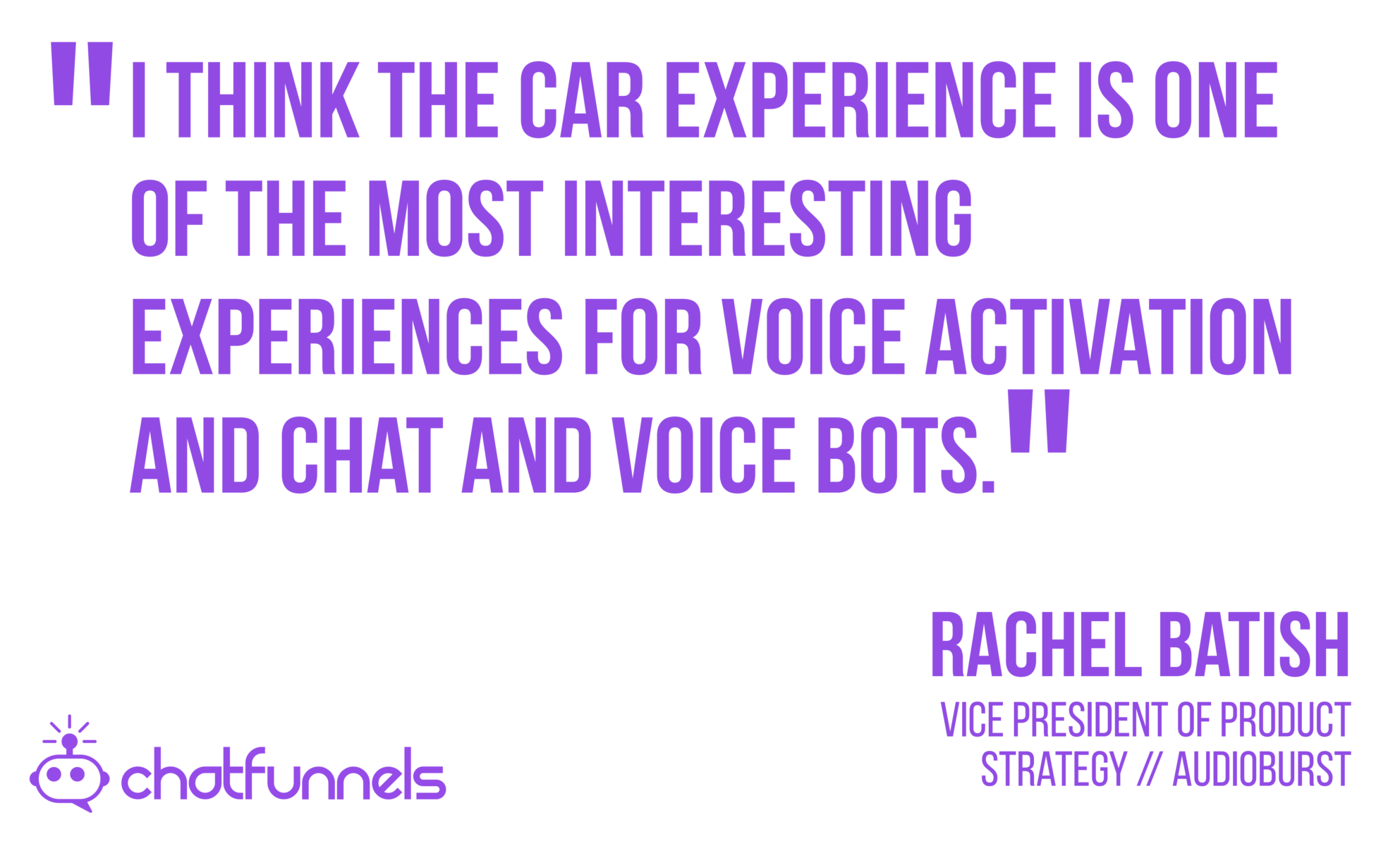
Rachel: It’s definitely gonna be part of the experience no matter where we’re going to deploy our solutions. We were just talking earlier before the podcast started that Audioburst is basically an ecosystem that connects content creators, it could be you know the radio stations and networks and it could be a podcaster himself, with our whole distribution channels. So we work with web and app publishers. We work with car manufacturers, consumer electronics. We take advantage of that sometimes not even an on demand content of radio content is linear.
You take that we kind of help them form that on-demand content. We chop it into those bursts there are 30 seconds to for five minutes. And then we usually serve it to our distribution partners. So definitely with the car experience I think is one of the most interesting experiences for voice activation and chat and voice bots. So we do have some work, we were launched on the Google automotive OS at the end of last year so that’s very exciting. Being able to continue the conversation from the Google assistant to our own application.
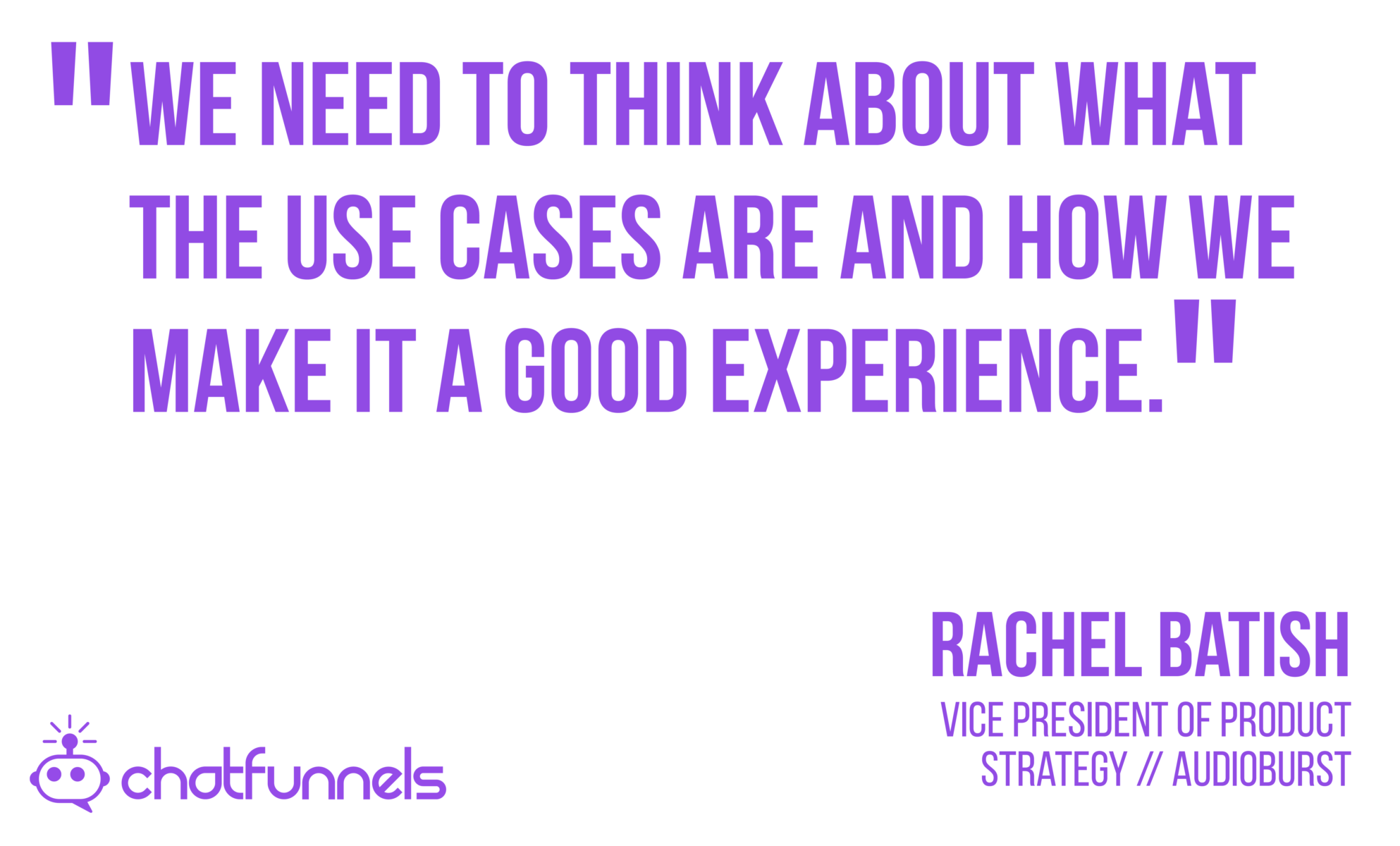
So that that’s pretty fascinating and we are actually available also on Amazon Alexa, our skill is called news feed. We have a Google action. We do invest the not a lot maybe but we do invest some time in the bot idea but I think that just like we said a minute ago we need to think what are the use cases and how do we make it a good experience, not just a frustrating one and where would I need it.
Billy: I mean in the car it makes 100% sense that that would be the main place. That’s where I listen to most of my audio and I think it’s for most people and getting your car, hands free. If you can just say hey play something about chatbots or give me the sports scores whatever you want.
Rachel: You have to go and download our apps because we have both an Android in an Apple IOS app. Try to do it with Audioburst and you will see it’s a great experience, that’s what we’re focusing on.
Billy: I’ll give it a shot. So before I let you go I wanted to ask you is there anything that I should have asked you that I didn’t? You’re thinking hey man is this Billy guy was really smart you would have asked me about this.
Rachel: You didn’t ask me what people will not find on my social media account.
Billy: Right yeah so let’s close up with that. So if we’re gonna look up Rachel what are we not gonna know about you from social?
Rachel: That’s the question that i really had to think of a lot. I’m not sharing so much. But I think like the things that I am sharing are kind of revealing everything about me. I’m vegan, so you’ll see a lot of vegan stuff. And I’m all for animal rights so you’ll see a lot about that.
I think people will not see the challenges that I’m facing everyday. We’re just not sharing that. And maybe we should change that. But definitely for me I kind of keep my personal life to myself on social media as well. Those are the things that you’re not but if you’re looking for vegan recipes or something like that on my social account.
Billy: Yeah thanks for sharing that’s very true. We don’t share challenges. We just share the highlights and that could be really tough. You’re right maybe we should be sharing more of that on social. So thank you again Rachel. If people want to reach out and continue the conversation with you how can they contact you?
Rachel: I’m on Linked In, Rachel Battish, you can email me at rachelb@audioverse.com and I’m happy to hear from everyone.
Billy: OK thank you Rachel
Rachel: Thanks Billy.
